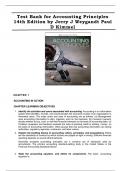Exam (elaborations)
TEST BANK FOR Accounting Principles 14th Edition by Jerry J. Weygandt, Paul D. Kimmel & Jill E. Mitchell , ISBN: 9781119707110 || Guide A+
CHAPTER 1 ACCOUNTING IN ACTION CHAPTER LEARNING OBJECTIVES 1. Identify the activities and users associated with accounting. Accounting is an information system that identifies, records, and communicates the economic events of an organization to interested users. The major users and uses of accounti...
[Show more]



